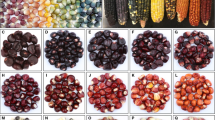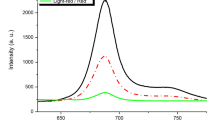Abstract
This work resulted in the development of a method based on fluorescence spectroscopy to differentiate between three corn varieties, standard, mutant and sweet, and to characterize the corn variety present in finished products. This was achieved by recording fluorescence emission spectra as a function of excitation wavelength. For a standard, non-transgenic and non-sweet corn, the maximum of the first peak is around 412–414 nm at the excitation wavelength equal to 280 nm and shifts to the longer emission wavelengths as the excitation wavelength increases. Also, the second peak is located at 535 nm or is slightly higher (537 to 540 nm) and does not vary for excitation wavelengths from 280 to 360 nm. For mutant corn, the position of the first peak is located at 420 nm and above for λex = 280 nm, while the second peak starts at 525–530 nm (depending on the mutant) and never reaches 535 nm. Finally, for a sweet corn, the position of the first fluorescence emission peak is around 430 nm. If the sweet corn is non-hybrid, the position of the second emission peak is at 535 nm. A hybrid sweet corn has its second peak around 530 nm. Thus, fluorescence emission at 530 is characteristic of corn that has undergone natural or artificial genetic transformation. Finally, we found simple mathematical equations to calculate the percentage of amylopectin and amylose in a given corn.



















Similar content being viewed by others
References
Albani JR (2014) Origin of tryptophan fluorescence lifetimes. Part 2: fluorescence lifetimes origin of tryptophan in proteins. J Fluoresc 24:105–117
Sezgin E, Betul Can F, Schneider F, Clausen MP, Galiani S, Stanly TA, Waithe D, Colaco A, Honigmann A, Wüstner D, Platt F, Eggeling C (2016) A comparative study on fluorescent cholesterol analogs as versatile cellular reporters. J Lipid Research 57:299–309
Okamutu A (2019) Next-generation fluorescent nucleic acids probes for microscopic analysis of intracellular nucleic acids. Appl Microsc 49:14. https://doi.org/10.1186/s42649-019-0017-1
Gajdos T, Hopp B, Erdélyi M (2020) Hot-band anti-stokes fluorescence properties of alexa fluor 568. J Fluoresc 30:437–443
Albani JR (1998) Dynamics of Trp residues in crystals of human arAeid glycoprotein (Orosomucoid) followed by red-edge excitation spectra. J Fluoresc 8:213–224
Farrokhi G, Paykarestan B (2010) The effect of pyridoxine and different levels of nitrogen on physiological indices of corn (Zea Mays L.var.sc704). World Academy of Science, Engineering and Technology International Journal of Agricultural and Biosystems Engineering 4:396–398
Woodworth JC, Goodband RD, Nelssen JL, Tokach MD, Musser RE (2000) Added dietary pyridoxine, but not thiamin, improves weanling pig growth performance. J Anim Sci 78:88–93
Tambasco-Studart M, Titiz O, Raschle T, Forster G, Amrhein N, Fitzpatrick TB (2005) Vitamin B6 biosynthesis in higher plants. PNAS 102:13687–13692
Faize L, Faize M (2018) Functional analogues of salicylic acid and their use in crop protection. Agronomy 8:5. https://doi.org/10.3390/agronomy8010005
Zandomeneghi M (1999) Fluorescence of cereal flours. J Agric Food Chem 47:878–882
Lenhardt L, Zeković I, Dramićanin T, Milićević B, Burojević J, Dramićanin MD (2017) Characterization of cereal flours by fluorescence spectroscopy coupled with PARAFAC. Food Chem 229:165–171
Acknowledgment
The Author wishes to thank Biogemma Company for providing the different grounded corns, Dr. Daniel Kmiecik (Université de Lille) (actually retired) for providing corn from Saint-Amand-Les-Bains and the reviewers for their constructive criticisms.
Author information
Authors and Affiliations
Corresponding author
Additional information
Publisher’s Note
Springer Nature remains neutral with regard to jurisdictional claims in published maps and institutional affiliations.
Rights and permissions
About this article
Cite this article
Albani, J.R. Fluorescence Characterization of Standard, Mutant and Sweet Corn. J Fluoresc 30, 1261–1270 (2020). https://doi.org/10.1007/s10895-020-02601-3
Received:
Accepted:
Published:
Issue Date:
DOI: https://doi.org/10.1007/s10895-020-02601-3




